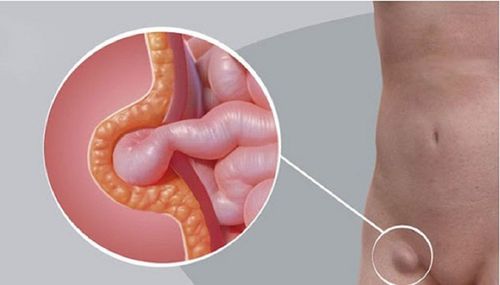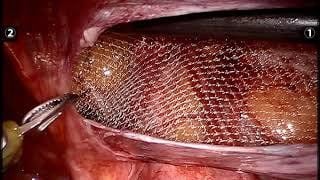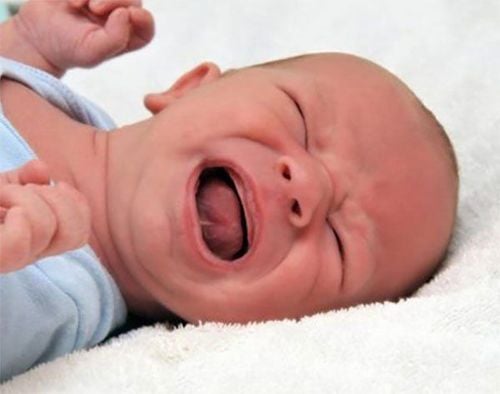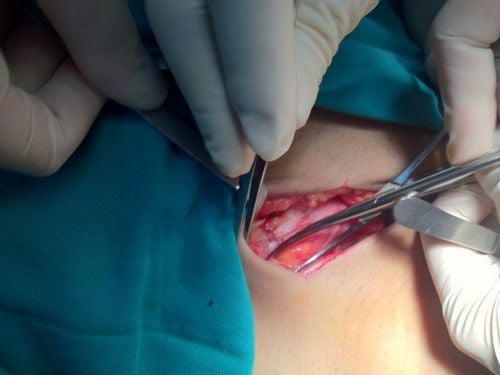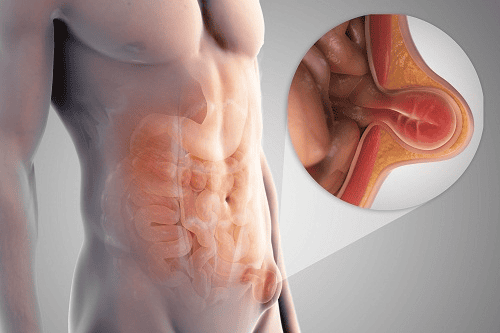This is an automatically translated article.
Inguinal hernia can occur in all subjects, sometimes the patient does not pay attention and is discovered by accident. However, attention can detect early typical signs of an inguinal hernia. When inguinal hernia needs to be treated early, if not treated for a long time, the hernia tends to enlarge and cause dangerous complications.
1. What is an inguinal hernia?
The inguinal canal has a tubular structure, located between the muscles of the abdominal wall, lying obliquely in the direction from back to front, from top to bottom and from outside to inside. The inguinal canal in adults is about 3 to 5 cm long, located about 2 cm above the junction from the anterior superior iliac spine to the pubic spine. The inguinal canal can be imagined as a cylindrical tube with two ends being the deep inguinal ring and the shallow inguinal ring, while the tube body is surrounded by four walls.
In the inguinal canal contains important components such as spermatic cord (vas deferens, testicular arteries) in men and round ligaments in women.
Inguinal hernia is a condition in which a part of the abdomen (usually the intestines, soft tissues...) escapes into the inguinal canal for some reason, which can be congenital or acquired.
When the hernia is large, it will cause compression on important organs of the inguinal canal, or the hernia will be blocked and cause very dangerous necrosis.
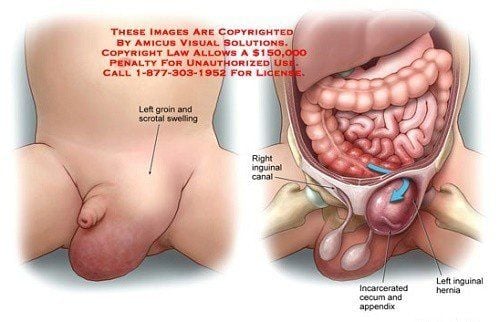
Hình ảnh khối thoát vụ bẹn gây chèn ép các tổ chức quan trọng của ống bẹn
2.Causes and favorable factors causing inguinal hernia
Causes of inguinal hernias :
Congenital: Due to a structure in the inguinal canal, it was supposed to close shortly after birth but for some reason it didn't. Thus, the intra-abdominal contents pass through this duct, creating an indirect hernia sac that is available. Acquired: Due to the weakening of the abdominal wall, often causing direct hernia. The cause of abdominal wall weakness can be old age, some diseases that cause collagen loss in tissues such as Ehler Danlos syndrome, malnutrition or obesity, incision or injury in the groin area... direct inguinal. Favorable factors:
Due to gender: The disease can occur in both sexes. However, men have a higher incidence than women. Constipation: If you have long-term constipation, this is also one of the main predisposing factors for inguinal hernia. Pregnancy: Pregnancy increases abdominal pressure, increasing the risk of inguinal hernia in women. Premature babies: Risk factors for congenital hernia in children, infants... Due to some diseases such as cystic fibrosis or chronic cough disease. Smoking cigarettes regularly. People who have a profession or have to stand for a long time. People with a family history of inguinal hernia.

Trong quá trình mang thai có nguy cơ thoát vị bẹn ở phụ nữ
3.Some signs of inguinal hernia
Most cases of inguinal hernia cause no discomfort to the patient, so it is often discovered incidentally during inguinal examination. Some typical signs of an inguinal hernia include:
A bulge in the groin area. This mass sometimes disappears on its own with relaxation, or appears to increase with increased intra-abdominal pressure such as coughing, sneezing, crying, straining, carrying heavy loads... For men, when the herniated mass descends to the scrotum , will cause one side of the scrotum to be abnormally large compared to the other. When palpating the soft, movable hernia, the patient can sometimes push the hernia up by hand. The hernia is usually painless, and sometimes feels light or heavy. Some signs when complications appear: Seeing the hernia mass is swollen, hot, red, painful, accompanied by fever, this is a condition where the hernia mass is blocked, reducing blood supply to the herniated visceral part, if the hernia mass The patient's intestines see other symptoms such as vomiting and nausea. If not treated promptly, it will cause necrosis due to insufficient blood supply to the hernia. Compression of surrounding structures: In men, when a large hernia goes into the scrotum, it presses on the spermatic cord, affecting blood vessels, causing pain and swelling of the scrotum. Inguinal hernia has very typical signs of disease, almost the diagnosis only needs to be based on clinical factors.
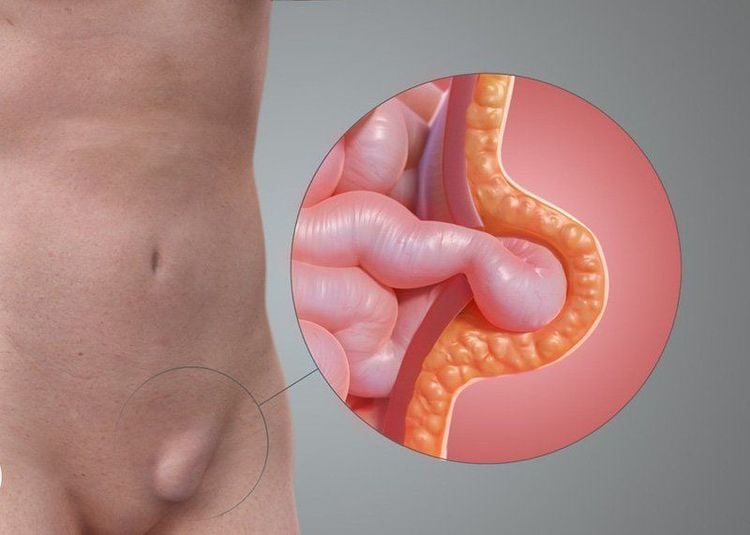
Xuất hiện một khối phồng ở vùng bẹn có thể là dấu hiệu của thoát vị bẹn
4.How to treat inguinal hernia
The main treatment of inguinal hernia is surgical surgery. When the inguinal hernia has been diagnosed, surgery is usually indicated, except for some special cases.
The surgery for inguinal hernia should be carried out early, the longer it is left, the bigger the hernia mass and the higher the risk of causing dangerous complications.
When choosing surgery, the patient can have laparoscopic surgery or open surgery. Inguinal hernia surgery to close the hernia and reconstruct the abdominal wall by placing a mesh is the commonly used method.
Signs of inguinal hernia are often very typical, the diagnosis is mainly based on clinical signs. However, many patients do not pay attention, so it is possible to ignore the disease and detect the disease when there are complications. Therefore, observing the abnormal changes of the body is important to detect your own health problems.
Vinmec International General Hospital applies laparoscopic surgery to treat inguinal hernia - the method is considered the most advanced today in the treatment of this pathology. Advantages of inguinal hernia surgery at Vinmec include:
The biggest advantage of this method is that the surgeon can easily see the vas deferens and blood vessels feeding the testicles, and at the same time can stitch the peritoneal canal. (the cause of an inguinal hernia) without affecting the vas deferens or the blood vessels supplying the testicles. Therefore, laparoscopic surgery avoids two dangerous complications, namely vasectomy or testicular atrophy, complications that can be encountered during open surgery. In addition, laparoscopy also allows assessment of the contralateral peritoneal tube and suture immediately if it remains open. Therefore, it is possible to prevent inguinal hernia on the opposite side. Besides, compared with the 2cm long incision of open surgery, laparoscopic surgery has high aesthetics with only 2mm incision, almost no scars after surgery. Laparoscopic surgery to treat inguinal hernia is painless, recovers early, and can be discharged from the hospital only 1 day after surgery.
Please dial HOTLINE for more information or register for an appointment HERE. Download MyVinmec app to make appointments faster and to manage your bookings easily.




